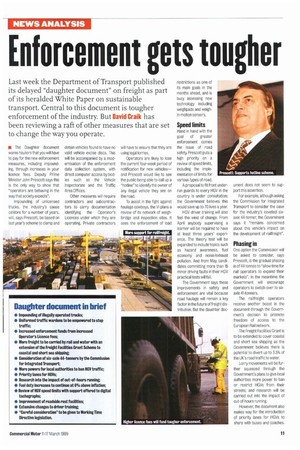Enforcement gets tougher
Page 13

If you've noticed an error in this article please click here to report it so we can fix it.
Last week the Department of Transport published its delayed "daughter document" on freight as part of its heralded White Paper on sustainable transport. Central to this document is tougher enforcement of the industry. But David Craik has been reviewing a raft of other measures that are set to change the way you operate.
11 The Daughter document warns hauliers that you will have to pay for the new enforcement measures, including impounding, through increases in your licence fees. Deputy Prime Minister John Prescott says this is the only way to show that "operators are behaving in the way that society expects".
Impounding of unlicensed trucks, the industry's cause celebre for a number of years, will, says Prescott, be based on last year's scheme to clamp and detain vehicles found to have no valid vehicle excise discs. This will be accompanied by a modernisation of the enforcement data collection system, with direct computer access by bodies such as the Vehicle Inspectorate and the Traffic Area Offices.
Other measures will require contractors and subcontractors to carry documentation identifying the Operator's Licences under which they are operating. Private contractors will have to ensure that they are using legal lorries.
Operators are likely to lose the current four-week period of notification for new vehicles— and Prescott would like to see the public being able to call up a "hotline" to identify the owner of any illegal vehicle they see on the road.
To assist in the fight against haulage cowboys, the VI plans a review of its network of weighbridge and inspection sites. It sees the enforcement of load restrictions as one of its main goals in the months ahead, and is busy assessing new technology including weighpads and weighin-motion sensors.
Speed limits
Hand in hand with the goal of greater enforcement comes the issue of road safety. Prescott puts a high priority on a review of speed limits, including the implementation of limits for various types of road.
A proposal to fit front underrun guards to every HGV in the country is under consultation; the Government believes this would save up to 70 lives a year.
HGV driver training will also feel the wind of change. From April anybody supervising a learner will be required to have at least three years' experience. The theory test will be expanded to include topics such as hazard awareness, fuel economy and noise/exhaust pollution. And from May candidates committing more than 16 minor driving faults in their HGV practical tests will fail.
The Government says these improvements in safety and enforcement are vital because road haulage will remain a key factor in the future of freight distribution. But the dauebter doe
ument does not seem to support this assertion.
For example, although asking the Commission for Integrated Transport to consider the case for the industry's coveted sixaxle 44-tonner, the Government says it "remains concerned about this vehicle's impact on the development of railfreight".
Phasing in
One option the Commission will be asked to consider, says Prescott, is the gradual phasing in of 44 tonnes to "allow time for rail operators to expand their markets". In the meantime the Government will encourage operators to switch over to sixaxle 41-tonners.
The railfreight operators receive another boost in the document through the Government's decision to promote freedom of access to the European Rail network.
The Freight Facilities Grant is to be extended to cover coastal and short sea shipping as the Government believes there is potential to divert up to 3.5% of the UK's road traffic to water.
Lorry movements will be further squeezed through the Government's plans to give local authorities more power to ban or restrict HGVs from their streets; and research will be carried out into the impact of out-of-hours running.
However, the document also makes way for the introduction of priority lanes for HGVs to share with buses and coaches.












































































































